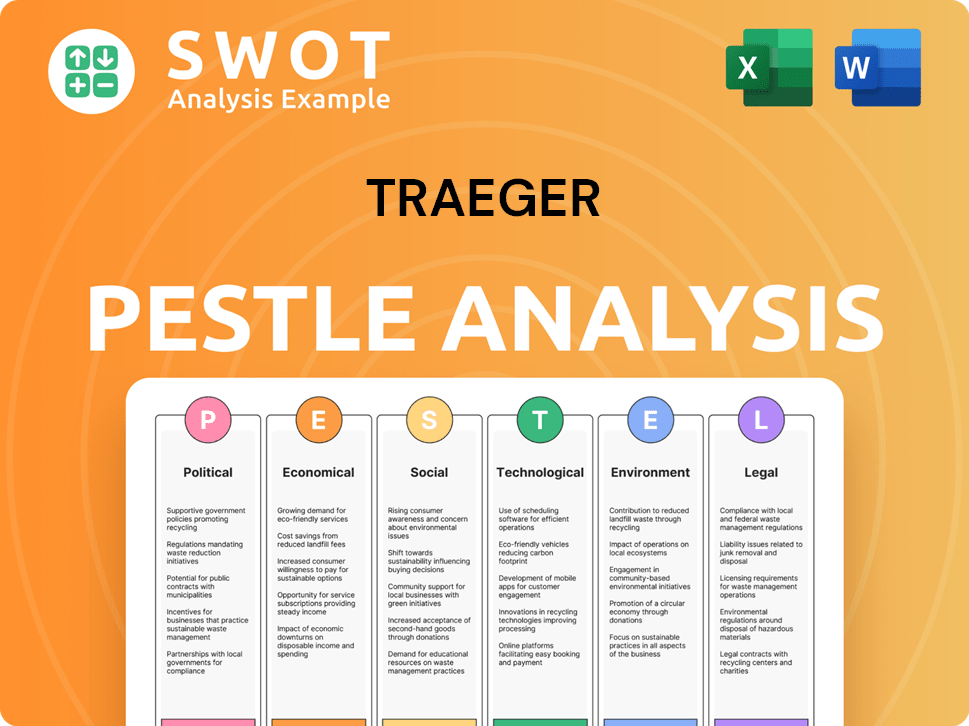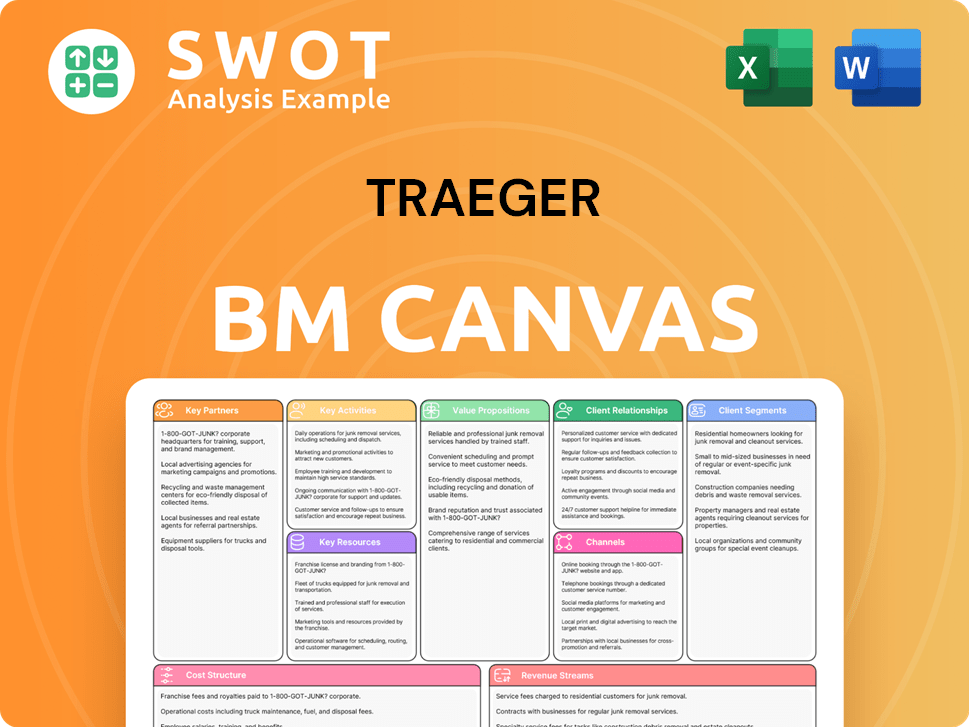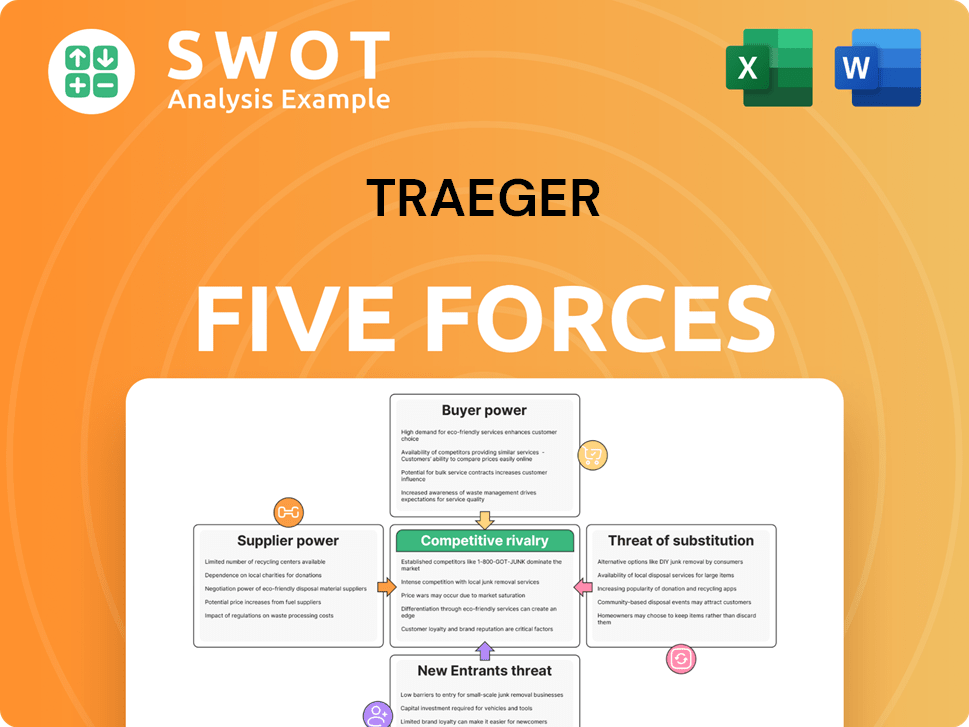Traeger Bundle
Who Buys Traeger Grills?
Understanding the Traeger SWOT Analysis is crucial for any company aiming for long-term success, and for Traeger, a leader in outdoor cooking, this means deeply understanding its customer base. From its roots as a pioneer of wood pellet grills, Traeger has cultivated a unique position in the market. This exploration dives into the Traeger company's customer demographics and target market, revealing the key factors driving its success.

The evolution of the Traeger target market is a fascinating case study in brand building and market adaptation. Analyzing customer demographics like age, income, and lifestyle, alongside understanding the BBQ audience and smoker market, helps explain the company's strategic shifts. This analysis offers valuable insights into Traeger grill customer buying habits and preferences, providing a roadmap for future growth.
Who Are Traeger’s Main Customers?
Understanding the Marketing Strategy of Traeger requires a deep dive into its primary customer segments. The company primarily focuses on the B2C market, targeting individuals passionate about outdoor cooking and the unique flavors of wood-fired grilling. This focus is evident in their product offerings and marketing efforts, aiming to attract and retain a loyal customer base.
The core of the Traeger target market consists of consumers who value high-quality grilling experiences. These individuals are often serious grillmasters and BBQ enthusiasts who appreciate top-notch construction and ample grilling space. They are drawn to the superior cooking capabilities and the distinct taste that wood pellets provide, making Traeger grills a premium choice in the market.
In March 2024, the typical barbeque grill shopper was predominantly a homeowner (70%) and married (61%). Millennials (31%) and Gen X (32%) make up the largest generational segments of grill purchasers. Baby Boomers account for 25% of purchases. The increasing share of purchases by Millennials and Gen Z, coupled with strategic product launches, shows the company's adaptability to evolving consumer preferences.
The grill demographics reveal a diverse customer base. While a significant portion of purchases (44%) involved only male shoppers, 30% involved only female shoppers, and 26% involved both male and female participation. This indicates a broad appeal across different household dynamics. The data suggests that the company caters to various household structures and cooking preferences.
Grill sales remain a strong segment for Traeger. In Q1 2025, grill revenue increased by 12.8% to $87 million, accounting for 60.5% of total revenue. For the full year 2024, grill revenues increased by 8.5% to $324.7 million. This demonstrates robust consumer demand and the continued success of their core product line.
The Traeger company strategically targets several key customer segments, including grill enthusiasts, families, and urban dwellers. The company's product range caters to those seeking premium grilling experiences and those looking for user-friendly options with intelligent temperature control and generous cooking space. The introduction of the Flatrock 2 Zone Griddle further expands its market reach.
- Grillmasters and BBQ Enthusiasts: These customers prioritize top-notch construction and an unparalleled grilling experience, especially interested in premium models like the Timberline Series.
- Families and Individuals: They enjoy hosting and showcasing their culinary skills, with models like the Pro Series offering intelligent temperature control and generous cooking space.
- Urban Dwellers: The launch of products like the Flatrock 2 Zone Griddle, with its more compact design, indicates a strategic move to capture additional market segments, including urban dwellers with limited outdoor space.
Traeger SWOT Analysis
- Complete SWOT Breakdown
- Fully Customizable
- Editable in Excel & Word
- Professional Formatting
- Investor-Ready Format

What Do Traeger’s Customers Want?
The success of the [Company Name] hinges on understanding its customers' needs and preferences. These customers are primarily driven by a desire for convenient, flavorful outdoor cooking experiences that deliver consistent results. They seek the distinctive smoky flavor that wood pellets provide, a characteristic not easily replicated by gas, charcoal, or electric grills. Key purchasing behaviors are shaped by ease of use, consistent temperature control, and the versatility to handle various cooking styles, including smoking, grilling, baking, and roasting.
The psychological and aspirational motivations for choosing [Company Name]'s offerings often involve the desire to be a 'backyard hero' and to enhance their outdoor cooking skills, irrespective of their prior experience. [Company Name] addresses this by providing smart grill features, such as WiFIRE technology, which allows users to program cook cycles, monitor temperatures, and control their grill remotely through the [Company Name] app. This technology also sends notifications for low pellet levels or when food is ready, simplifying the grilling process.
Customer feedback and market trends have significantly influenced [Company Name]'s product development. The company continues to invest in product innovation, with successful launches like the Woodridge Series and the Flatrock 2 Zone griddle in 2025. The focus on 'Smart Combustion' technology in newer models like the Ironwood series demonstrates a commitment to maintaining consistent cooking temperatures, a key preference for many grillers. Furthermore, [Company Name] tailors its offerings by introducing a range of wood pellet flavors, rubs, and sauces, allowing consumers to customize their grilling experience and encouraging recurring revenue. The company also provides original culinary content, including recipes, tips, and live cooking classes, to inspire and educate its users, fostering a strong 'Traegerhood' community.
Understanding the customer base is crucial for [Company Name]'s success. The Traeger target market values convenience, flavor, and consistent results, seeking the unique smoky taste of wood pellets. They prioritize ease of use, temperature control, and cooking versatility, which is why Owners & Shareholders of Traeger are always looking for new ways to improve their products.
- Grill demographics show a preference for smart technology, with features like WiFIRE technology for remote control and monitoring.
- Customers are drawn to the aspirational aspect of becoming skilled outdoor cooks, regardless of their experience level.
- Product development is driven by customer feedback, with innovations like the Woodridge Series and the Flatrock 2 Zone griddle in 2025.
- The company focuses on consistent cooking temperatures through 'Smart Combustion' technology, a key preference for grillers.
- Customization options, such as various wood pellet flavors, rubs, and sauces, encourage recurring revenue.
- Culinary content, including recipes and classes, fosters a strong community.
Traeger PESTLE Analysis
- Covers All 6 PESTLE Categories
- No Research Needed – Save Hours of Work
- Built by Experts, Trusted by Consultants
- Instant Download, Ready to Use
- 100% Editable, Fully Customizable

Where does Traeger operate?
The geographical market presence of the [Company Name] is significantly concentrated in North America, which serves as its primary revenue generator. The United States holds a dominant position within the BBQ grills market, with over 35% market share. This strong foothold is complemented by contributions from Europe and the Asia-Pacific regions, which account for 25% and 20%, respectively.
In the wider pellet grills and smokers market, North America led with 35.45% of global market revenue in 2025. Europe followed with 24.10%, and the Asia Pacific region contributed 24.05%. This data highlights the importance of the North American market for [Company Name] while also showing the growing significance of international markets.
The company employs an omnichannel distribution strategy to reach customers worldwide. This strategy includes partnerships with major retailers like Ace Hardware, The Home Depot, and Costco, as well as e-commerce platforms such as Amazon. Direct-to-consumer (DTC) sales through its website and the Traeger app are also crucial. As of December 31, 2024, [Company Name] products were available in over 11,200 retail locations globally.
North America remains the strongest market for [Company Name], driving a significant portion of its revenue. The United States, in particular, is a key market for the company. This strong presence is crucial for understanding the overall customer demographics and market dynamics.
The company has been actively expanding its global footprint. Successful launches in Canada and MEATER distribution in the UK in Q1 2025 demonstrate its commitment to international growth. These initiatives are part of the company's strategy to reach a broader BBQ audience.
International market performance has been mixed. Some regions experienced improved holiday sales, while others faced destocking impacts in distributor markets during 2023. These variations underscore the need for tailored strategies to address regional differences in Traeger target market behavior.
A majority of [Company Name]'s revenue comes from North America, with the 'Rest of the world' segment contributing the remainder. This distribution emphasizes the importance of the North American market while highlighting the potential for growth in other regions. Understanding the smoker market is essential for strategic planning.
The company employs localization strategies to succeed in diverse markets. These strategies involve adapting offerings and marketing to fit local consumer behaviors, preferences, and buying power. Analyzing Traeger grill customer age and other demographics is crucial.
The company uses an omnichannel distribution strategy. This approach includes major retailers, e-commerce platforms, and DTC sales. This wide distribution network helps the company reach a broad Traeger grill demographic profile.
Traeger Business Model Canvas
- Complete 9-Block Business Model Canvas
- Effortlessly Communicate Your Business Strategy
- Investor-Ready BMC Format
- 100% Editable and Customizable
- Clear and Structured Layout

How Does Traeger Win & Keep Customers?
The [Company Name] employs a comprehensive strategy for acquiring and retaining customers, utilizing a blend of digital and traditional marketing channels. A key focus is on building brand awareness and expanding market share, which are critical strategic initiatives for 2025. This approach is designed to reach the target audience, from casual grillers to professional chefs, fostering a loyal customer base.
Central to [Company Name]'s brand strategy is the 'Traegerhood' community. This community engagement, combined with original culinary content, recipes, tips, and live cooking classes, inspires owners to use their grills frequently. This strategy encourages engagement with the brand and drives recurring revenue through the purchase of consumables like wood pellets, rubs, and sauces.
The company utilizes an omnichannel distribution strategy, offering products through major retailers and direct-to-consumer sales via its website and the Traeger app. Strategic pricing and promotional activities drive unit volume growth, especially in the grill segment. This multi-faceted approach aims to attract and retain customers effectively.
Building brand awareness is a core strategy for [Company Name]. They leverage various marketing channels to reach potential customers. This includes digital marketing, traditional advertising, and community engagement to increase visibility.
An omnichannel distribution strategy is crucial for reaching a wide customer base. Products are available through major retailers and direct-to-consumer sales. This approach provides convenience and accessibility for customers.
The 'Traegerhood' community is central to the brand's strategy. It fosters a passionate and engaged user base. This community engagement drives loyalty and repeat purchases.
Product innovation, like the Woodridge series, contributes to revenue growth. The launch of new products helps attract new customers. This strategy also enhances the company's market position.
To enhance customer loyalty, [Company Name] focuses on improving retail execution and customer experience, especially during peak grilling seasons. Investment in IoT infrastructure, enabling smart grill features and mobile app integration, boosts customer satisfaction and retention. This connected platform promotes ongoing engagement and repeat purchases of consumables. For a deeper dive into the company's origins, check out Brief History of Traeger. In Q1 2025, the grill segment saw a 12.8% increase in revenue due to product launches and strategic pricing. The adjusted net income improved to $7 million in Q1 2025 from $5 million in Q1 2024, indicating progress in financial stability.
Traeger Porter's Five Forces Analysis
- Covers All 5 Competitive Forces in Detail
- Structured for Consultants, Students, and Founders
- 100% Editable in Microsoft Word & Excel
- Instant Digital Download – Use Immediately
- Compatible with Mac & PC – Fully Unlocked

Related Blogs
- What are Mission Vision & Core Values of Traeger Company?
- What is Competitive Landscape of Traeger Company?
- What is Growth Strategy and Future Prospects of Traeger Company?
- How Does Traeger Company Work?
- What is Sales and Marketing Strategy of Traeger Company?
- What is Brief History of Traeger Company?
- Who Owns Traeger Company?
Disclaimer
All information, articles, and product details provided on this website are for general informational and educational purposes only. We do not claim any ownership over, nor do we intend to infringe upon, any trademarks, copyrights, logos, brand names, or other intellectual property mentioned or depicted on this site. Such intellectual property remains the property of its respective owners, and any references here are made solely for identification or informational purposes, without implying any affiliation, endorsement, or partnership.
We make no representations or warranties, express or implied, regarding the accuracy, completeness, or suitability of any content or products presented. Nothing on this website should be construed as legal, tax, investment, financial, medical, or other professional advice. In addition, no part of this site—including articles or product references—constitutes a solicitation, recommendation, endorsement, advertisement, or offer to buy or sell any securities, franchises, or other financial instruments, particularly in jurisdictions where such activity would be unlawful.
All content is of a general nature and may not address the specific circumstances of any individual or entity. It is not a substitute for professional advice or services. Any actions you take based on the information provided here are strictly at your own risk. You accept full responsibility for any decisions or outcomes arising from your use of this website and agree to release us from any liability in connection with your use of, or reliance upon, the content or products found herein.